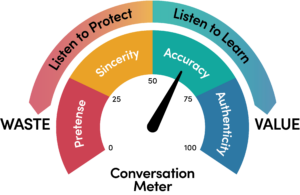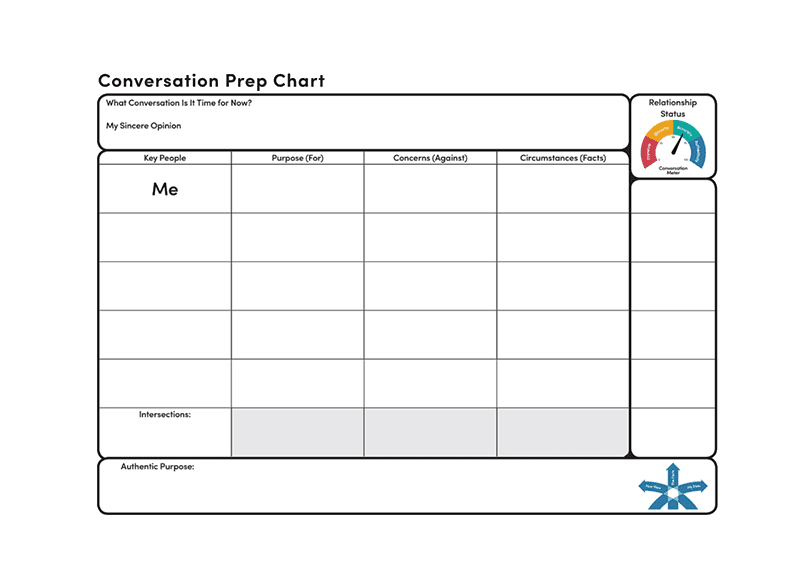From Stuck To Successful: Use The Conversation Meter to Build Leadership Development Skills for New Managers
Congrats – you’ve just been promoted! But, now you feel the weight of your new leadership responsibilities. You’re not alone. The transition from individual contributor to team leader can be exhilarating, but it often comes with unexpected communication hurdles. This is where leadership coaching for executives is key.
Enter a simple yet transformative tool called the Conversation Meter—a framework that helps you recognize when dialogue is heading off course and shows you how to steer it toward collaboration and results.
Why the Conversation Meter Matters
Imagine a scale from 0 to 100, showing how open and productive a conversation is:
- 0–25: Pretense – People withhold or distort the truth, deflect blame, or avoid uncomfortable topics.
- 26–50: Sincerity – Individuals share honest opinions but tend to be more interested in proving they’re right than truly listening.
- 51–75: Accuracy – Everyone separates fact from assumption, actively seeking different points of view.
- 76–100: Authenticity – Dialogue is purposeful, candid, and respectful of all perspectives, leading to deeper trust and innovative solutions.
When a conversation falls below 50, it can quickly spiral into hidden agendas or stubborn positions. Above 50, curiosity and open-mindedness replace friction, inviting better ideas and clearer action steps. For new managers, moving conversations out of the “stuck” zone and into collaboration is a game-changer for effective leadership development skills.
A Real-Life Pivot
Picture a newly promoted supervisor named Trina. In her first team meeting, she noticed that discussions kept devolving into heated opinions. Recognizing they were stuck in “Sincerity,” she gently asked, “Could we identify what we know for sure versus what we’re guessing?” That one question diffused the tension and nudged everyone toward “Accuracy.” Within minutes, the conversation shifted from bickering to promoting cross-team collaboration, and they uncovered a solution that satisfied all sides.
Diving Deeper: The Four Ranges
perhaps add highlight colors to the ranges below?
- Pretense (0–25)
-
- Red Flag: Fear-based avoidance and hidden thoughts.
- Leadership Challenge: People hesitate to speak candidly, often leaving critical information off the table.
- Sincerity (26–50)
-
- Red Flag: Genuine opinions but little curiosity about others’ viewpoints.
- Leadership Challenge: Disagreements turn into deadlocks, and teams lose time debating rather than building solutions.
- Accuracy (51–75)
-
- Green Light: Fact-based exploration and a willingness to challenge assumptions.
- Leadership Advantage: The team becomes more resourceful, discovering new possibilities through shared information.
- Authenticity (76–100)
-
- Sweet Spot: Purpose-driven, candid dialogue that embraces different perspectives.
- Leadership Advantage: Deep trust, collective problem-solving, and synergy across the team.
Four Steps to Elevate Your Conversations and Build Leadership Development Skills
- Call Out What You Notice
If things feel stuck or confrontational, pause to note, “It seems we might be debating opinions rather than clarifying facts.” This simple acknowledgment invites the group to shift toward more open exchanges.
- Ask More, Assert Less
Replace “Here’s what I think…” with “How are you seeing this?” or “Could we test these assumptions?” Curiosity ensures that team members feel heard and are more willing to brainstorm together.
- Reference Concrete Examples
If tensions are rising, pivot to something tangible: “Last quarter’s product release ran late. What can we learn from that?” Grounding the discussion in real events or data helps reduce guesswork and blame.
- Verify Understanding and Commitments
Always wrap up by clearly restating who’s responsible for what: “So, Alex will finalize the user research by Friday, and Lesley will confirm budget details by Wednesday.” Clear next steps prevent confusion and foster accountability.
Your Conversation Meter Cheat Sheet
- Identify the current range (Pretense, Sincerity, Accuracy, or Authenticity).
- Ask clarifying questions like, “What do we know for sure?” or “Which parts are assumptions?”
- Guide the team upward by focusing on shared data, mutual purpose, and open inquiry.
- Confirm roles, responsibilities, and timelines before ending the discussion.
Ready to Shift Your Team from Stuck to Successful?
The Conversation Meter isn’t about “winning” debates—it’s about elevating dialogue, which is an important skill for leaders. The moment you catch your team spinning in conflict or silence, pause to gauge which range you’re in and guide them upward. Not only will you unlock better ideas, but you’ll also foster a sense of trust and momentum that’s vital for any new leader.
If you’re curious about how this might play out with your specific team dynamics, consider sharing your experiences or questions with peers. A single pivot toward more accurate and authentic dialogue can revolutionize the way you lead—and how your team delivers results.





